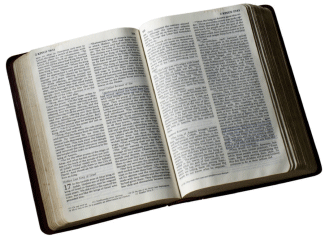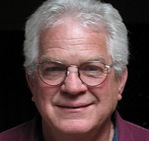An Observation on Rev. 14:12
By Jonathan Mitchell
 Following the declaration in Rev. 14:8 concerning the fall of Babylon the Great, in vs. 9 John sees another messenger (or: agent) following the other two (vss. 6 and 8) with a proclamation that begins in vs. 9 and carries on through vs. 12. It is the context of vss. 10-11 that answers the question of where the "Here" in vs. 12 is located. I will suggest that the word "Here," which begins vs. 12 is best read with the literal meaning, "In this place" - i.e., in that place in front of The little Lamb and that is surrounded by His set-apart agents (or: holy messengers; sacred folks with the message):
Following the declaration in Rev. 14:8 concerning the fall of Babylon the Great, in vs. 9 John sees another messenger (or: agent) following the other two (vss. 6 and 8) with a proclamation that begins in vs. 9 and carries on through vs. 12. It is the context of vss. 10-11 that answers the question of where the "Here" in vs. 12 is located. I will suggest that the word "Here," which begins vs. 12 is best read with the literal meaning, "In this place" - i.e., in that place in front of The little Lamb and that is surrounded by His set-apart agents (or: holy messengers; sacred folks with the message):
9. And another, a third agent (or: messenger), followed them, repeatedly saying in a great voice, "If anyone is continuously worshiping the little wild animal, and its image, and is continuously receiving an imprinted mark upon his forehead or upon his hand,
10. "he or she will also proceed drinking out of the wine of God's rushing emotion (strong passion; anger) - of the one having been mixed undiluted within the cup of His inherent fervor (natural bent; impulse; indignation; wrath). And he will proceed being examined (scrutinized with the touchstone to test his "mettle") within Fire and Deity (or: in union with Fire, even Divine qualities) in the presence of (before; in the sight of) the set-apart agents (sacred folks with the message; holy messengers), and in the presence of (before) the little Lamb."
11. And so the smoke of their examination and testing by the touchstone continually ascends on into ages of the ages. And those continually worshiping the little animal and its image - and if any one continually receives the imprinted mark (carve-effect) of its name - they, continually, are not having rest day and night [comment: day and night are representations of time elapsing on earth].
12. In this place is (or: Here exists) the persistent and patient endurance (the steadfast, humble remaining-under for support) of the set-apart folks (or: from the saints) - the people continually keeping watch upon (guarding, observing, having custody over) God's implanted goals (impartations of the finished product within; inward purposed directives and inner destiny) and the faith of Jesus (or: the trust pertaining to Jesus; the loyalty belonging to Jesus; the faith which belongs to and comes from Jesus; the conviction which is Jesus; the reliability of and from Jesus).
Traditionally, vs. 12 has been separated off from vss. 9-11 and thus has been made to be an enigmatic, stand-alone statement that left the reader wondering what John meant. Various attempts to solve that seeming enigma have been offered, over the centuries since John penned this vision, but including it within the context of the previous three verses eliminates the supposed "enigma," and enlightens the whole passage.
The purpose of this short observation is not to explain the setting, context or purpose of these four verses, but is to simply point out that vs. 12 points back to vss. 10-11, instructing us that
"In this place" - i.e., the place of the examination and testing of the person who is "continuously worshiping the little wild animal and its image" (vs. 9, and note the present tense of the verb) - "is [the very place of] the persistent and patient endurance of the set-apart folks."We can also observe that "this place" is
"in the presence of the set-apart agents and in the presence of the little Lamb" (i.e., Christ),
in vs. 10. Said another way,
"this place" is a place of "Fire and Deity (or: Divine qualities; Greek: theion)."
Notice that the phrase "set-apart folks" can also be rendered: "sacred folks with the message; holy messengers." I suggest that this is speaking of the called-out communities who have been seated together with Christ in the heavenlies (Eph. 2:6), right here on earth. Notice my comment that is inserted in vs. 11: day and night are representations of time elapsing on earth, as the earth turns. The setting was described in vss. 6-7,
"those situated (or: habitually sitting down) upon the Land (or: earth), and upon every multitude (nation; ethnic group), tribe, tongue, and people.... must worship the One making (the Maker; the One constructing and forming) the atmosphere (or: sky; heaven) and the earth (or: land; ground) and the sea and springs of water."
Both idolatry (worship of the little wild animal and its image) and true worship were happening in the same place and at the same time: here on earth, and in this book of visions: specifically the Land of Palestine/Israel.
Now let's look at how these people who have the message are described in vs. 12:
"the people continually keeping watch upon, guarding, observing and having custody over God's implanted goals, His impartations of the finished product within, as well as His inward purposed directives and inner destiny."
These folks have the message of all this and are in the presence of those who bear an animal's image instead of God's image. As God's transforming Fire (God Himself) and His Divine qualities do their work on these folks, the sacred messengers (the called-out, covenant communities) are there to inform them about God's goals and inner destiny for them that He is presently writing upon their hearts. Their work is to instruct them about the impartation of the finished product (Christ in them, so that they will bear God's image) which is the result of God's fire. They, by the message of the sacred folks in their presence, are in the process of being transformed by the renewing of their minds so that they, too, will have their Father's name written in their foreheads (vs. 1).
 This whole picture which John was observing is a reflection from Mal. 3 where Yahweh is described as being "like a refiner's fire" (vs. 2b). There, Malachi is instructed that Yahweh will
This whole picture which John was observing is a reflection from Mal. 3 where Yahweh is described as being "like a refiner's fire" (vs. 2b). There, Malachi is instructed that Yahweh will
"sit as a refiner and purifier of silver (note: the touchstone - vs. 10, above - was used to grade precious metals): and He shall purify the sons of Levi, and purge them as gold and silver that they may offer unto Yahweh and offering in righteousness" (vs. 3).
The setting in Mal. 3 was Judah and Jerusalem (vs. 4), just as it is in the book of Revelation. See my article, "The Location of the Lake of Fire."
Jonathan

Return To Jonathan Mitchell's Page